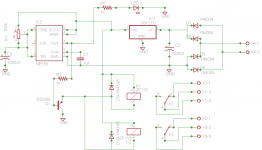this one first.
The current to the relay driving circuit comes from a source. That current MUST return to the same source.
The two wires supplying and returning that relay current should be a close coupled twisted pair. It should be obvious where the Return needs to terminate.
Thanks. Which means that the driving current will be attached to the negative plate of the capacitor in the power supply. On the breadboard implementation, the resistor acting as coil load is attached to this "ground". My confusion was in calling this "ground" as opposed to "circuit reference". Connecting to "ground" evokes notions of connecting to safety earth.
Last edited:
AndrewT, thank you for the detailed response. That was very illuminating.
You're suggestion of running the relay above 9 VDC happens to be the operate point for the chosen relay. Since you've noted that the relay runs cooler at or above operate voltage, the resistance would necessarily be lower at this point than at half way between operate and drop-out voltages. This would also mean that the overall power supply impedance ought to be lower.
Thanks again!
You're suggestion of running the relay above 9 VDC happens to be the operate point for the chosen relay. Since you've noted that the relay runs cooler at or above operate voltage, the resistance would necessarily be lower at this point than at half way between operate and drop-out voltages. This would also mean that the overall power supply impedance ought to be lower.
Thanks again!
I really do wish the Forum would ban the use of the word "ground"............. My confusion was in calling this "ground" as opposed to "circuit reference". Connecting to "ground" evokes notions of connecting to safety earth.
We should be compelled to spell out exactly and uniquely, where the Return goes.
I've said this a few times in the past.
Ground causes a lot of confusion and this confusion affects many thousands of our Members.
- Status
- Not open for further replies.

